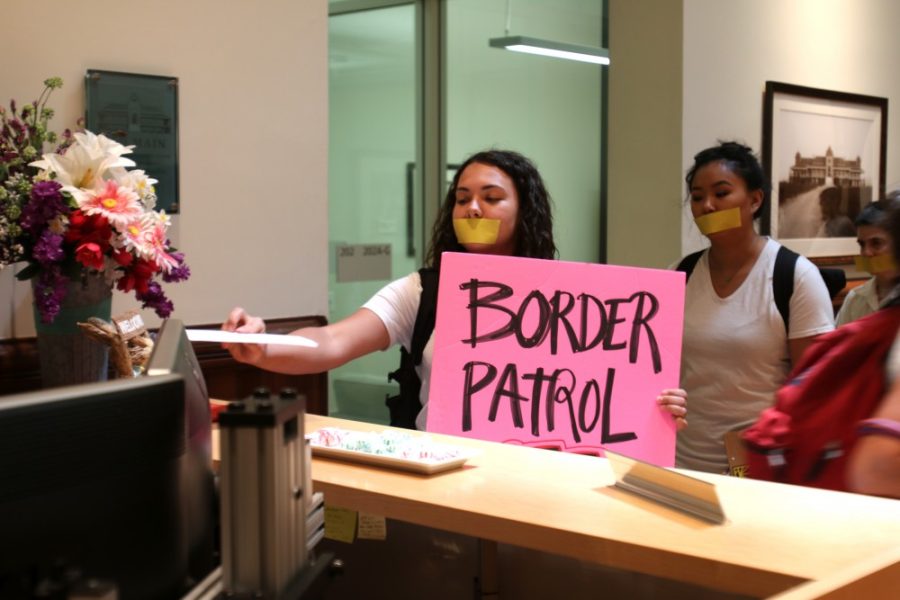University of Arizona students and staff members participated in a silent demonstration on the university’s campus yesterday at noon, following a series of protests relating to U.S. Customs and Border Protection’s presence on campus and criminal charges filed against three students.
The protesters, comprised of students and staff from various departments, wore white t-shirts that read “drop the charges,” “no ICE on campus” and “murder police.” Some protesters wore yellow tape over their mouths. Protesters also held signs expressing their displeasure with university President Dr. Robert Robbins’s handling of the situation.
RELATED: Protesters leave letters of support for ‘Arizona 3,’ demand action from Robbins
All three media liaisons present, Raquel Gutierrez, Liz Kinnamon and Farid Matuk confirmed the platform of today’s silent action was to stand in solidarity with the “Arizona 3” who were cited by the University of Arizona Police Department for interference with the peaceful conduct of an educational institution.
Gathering near University Boulevard and Park Avenue before the demonstration, Sandra Soto, an associate professor of gender and women’s studies, spoke to students regarding the platform of today’s protest. She also added a warning to the crowd.
“UAPD is watching us right now,” Soto said. “If any UAPD harasses you, if the police harass you, do not speak to the police. They are not our friends. Find one of the press liaisons or myself.”
No uniformed UAPD officers were present at the rally itself.
Following Soto, another organizer briefed the crowd on how the protest was to be conducted. Protesters were to line up single file, walk down the sidewalk on University Boulevard, cross onto the steps of Old Main and enter the building.
“It is important that when we go into Old Main, we are quiet,” organizers said. “We will not be entering president Robbins’ office, we will be dropping our letters off on the administrative assistant’s desk”.
Afterwards, protesters were to await further instruction on the UA Mall.
Media was directed to speak to press liaisons, who wore neon arm bands to signify to media they were open to comment. When asked to be interviewed, students directed media to these lesions to speak on the matter. These liaisons each come from a different part of the university; some were graduate students, and some faculty.
Farid Matuk is an associate English professor and one of the UA staff members involved in the movement.
“I think that, as a public institution, we need to focus on the conditions we’re creating for civil discourse,” Matuk said. “We haven’t created sensible policy that will balance on the one hand the right of any student group to interact with the Border Patrol and on the other hand the right of students who are made vulnerable by the residency status to access their educations right. There’s has to be some solution that balances both of those, that arriving at that kind of solution is going to create the conditions for civil discourse on campus.”
Raquel Gutierrez, a third-year creative writing graduate student, was one of three press liaisons present.
“It’s an opportunity to articulate my dissatisfaction with the way the administration handles the treatment of three students would charge for disrupting armed Border Patrol agents on campus,” Gutierrez said. “This is because of the culture that we’re in right now, in the way that black and brown communities all over the country have been at the hands of really violent law enforcement.”
Matuk expanded on the symbolism behind the tape on protesters’ mouths.
“I think it’s an attempt to signify an overabundance of caution, to make sure that this action is not criminalized in the way that the actions of those students were,” Matuk said. “The university seems to be making a distinction between speech and disruption, and so we want to make sure that our actions are not disruptive [and] highlight how complicated it is to really make that distinction.”
Gutierrez and her fellow liaisons said they had a specific purpose in their presence at this protest.
“I want to be careful here about not be speaking for the students, surely because we’re here to support the three students who were being charged. A variety of people here have different opinions,” said Liz Kinnamon, another press liaison and a sixth-year doctoral student in gender and women’s studies.
Along with concerns of student safety, Kinnamon mentioned the movement’s concerns for the conduct of agents at the border.
“Just last year, a Border Patrol agent was acquitted of involuntary manslaughter for killing a 16-year-old boy who was on the Mexican side of the border, and there are plenty of videos documenting border agents slashing water bottles for humanitarian aid,” she said.
First Amendment monitors were present at the protest, including Associate Dean of Students Chrissy Lieberman. Some helped direct pedestrian and bike traffic around the demonstration.
RELATED: Border Patrol union VP by campus conservative groups and protesters
After delivering their letters to Robbins, protesters gathered on the UA Mall. There, a graduate student, Gloria Negrete-Lopez, read the movement’s press release. The statement highlighted concerns of limits on student expression, disruptions to learning and Robbins’ handing of the situation.
Following Negrete-Lopez, a student announced a protest at the Arizona Board of Regents meeting Thursday. Students will speak before the board and about their concerns the alleged growing conflict on the University of Arizona’s campus. The students plan to gather at Freedom Hill in front of the UA Administration Building on UA campus at noon today.
Follow Maya Noto on Twitter









